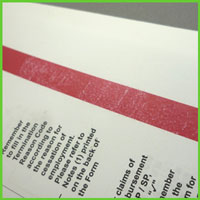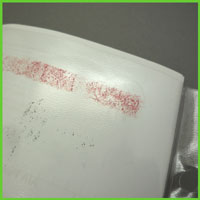| 30 DAYS MONEY BACK GUARANTEE | FREE U.S. SHIPPING $50+ ORDERS* |
| 30 DAYS MONEY BACK GUARANTEE | FREE U.S. SHIPPING $50+ ORDERS* |
Archival Safety & What are Sheet Protectors made of ?INFORMATION ON SHEET PROTECTORS AND ARCHIVAL SAFETY
Here you will find information about archival safety in connection with the use of binder accessory for storage of documents, Cd, diskettes, photos, business cards, laser and ink jet prints, etc.
Choosing pages & albums, have in mind that the album pages are the most important part of the two. The pages will have direct contact to the documents you are about to store and will so have the most influence on the long term storage effect. For this purpose it need to be acid free sheet protectors. The binders are of cause also important and should not be neglected in the archival process.
WHAT NOT TO DOPlastic enclosures manufactured from polyvinyl chloride ( PVC ) are NOT recommended for archival photographic or document storage. This plastic, often referred to as "vinyl" is not as chemical stable as some other plastics. It can contain volatile plasticizers (softener) and emit damaging hydrochloric acid as it deteriorates. This deterioration is often easy to detect as the plastic starts to get yellow, bridled and may even start to crack. Multiple page may even stick together, specially in warmer climate.Unfortunately before these signs shows it may be too late as the material in the sheet protector most likely have been smeared or copied on to the sheet protector itself. It happens very easy with laser prints and color printed collectors cards as baseball cards. In other words do not use vinyl or PVC sheet protectors for storage of any valuable belongings. Below are two images showing the irreversible damages that can be done to the document and the sheet protector, if its made from PVC. As you can clearly see, the red ink on the document is ruined, as well as the sheet protector itself as the red stick to it.   - PVC sheet protector damaging documents and the sheet protectors themselves. WHAT YOU NEED TO KNOWSo are sheet protectors acid free ? - Well to avoid the above horror scenario manufactures turned to other types of more chemical stable plastic, inert plastic that are considered archival safe as they don't interact with other plastic in general:
They all have their advantages. Polyethylene is the cheaper of the 3 being a softer and less stiff material the finish of the product is not as nice and not as clear as the two others materials. Polyester looks sharp and is very clear but it is an extremely expensive material got a tendency to become static and attract dust. Finally there are Polypropylene (PP). This material is considered archival safe as it is chemically stable and as close to PH neutral as technical possible with plastic and does not contain any plasticizers. It comes in many different grades of clarity and stiffness depend upon the thickness of the individual page. PVC BEING BANNED - is it harmful ?In some countries PVC has been banned for use with kids toys and other products coming in close contact to children. The softener in the PVC is widely believed to be released into the environment with time and being a possible source for cancer. Many studies has indicated this even though this is much disputed (read more here). In addition Polyvinyl chloride (PVC) also has the disadvantage of releasing toxic chloride fumes when ignited. In comparison Polypropylene (PP) which release Co2 and water vapor when ignited.Some would argue PVC is harmful but we can't yet live without it at present and it is used a lot in the medical field for IV tubes or bags for storage of blood plasma as blood cannot penetrate PVC an an example. Unlike poly materials which you may have experienced yourself when buying red meat at the supermarket and the blood seeping through the packing over time. IS THIS A VINYL PAGE I GOT ?Here is one easy way to check if your pages are made in vinyl (PVC). Open up the page and smell the air in it. If there is a "thick odor" to it, it is for sure made in vinyl / PVC. Polyester and Polypropylene are odor less, unfortunately so is some newer types of vinyl or there are a very limited odor or just a hint of it and it can be very hard to detect so this test is not 100% safe.KEEPFILING ONLY USE ARCHIVAL SAFE MATERIALSIt should be noticed that Keepfiling only market archival safe polypropylene sheet protectors and binders. We don't carry any PVC or Vinyl products. Products that use glue as part of the of its feature we stride to use water based glue that are PH neutral. As always don't use glue based products directly on the documents or photos that needs to be archived. They will be ruined.On rare occasions we may provide access to vinyl pages or vinyl binder if a customer request this specifically. We then make sure to highlight the fact it is not archival safe. ADDITIONAL INFORMATIONIf you need more information on this subject you can also check the National Archives they have a good article about how to choose the right album for photos. It is a good article but in general sums up what has been written above. See it here.You should also consider reading our sheet protector guide. It list much of the above in regards to archival safety but also consider other issues before making a purchase choice. If you should have further questions you are very welcome to contact us. We will do our utmost to help answer your questions or find answer to them should we not have the answer at hand.
Sign up for our newsletter here today and receive advises, discounts and promotions on our archival safe products!
** We don't sell or rent our mailing list. This is it ! Read our Privacy Policy ** Shop here for Document Protector from Keepfiling |